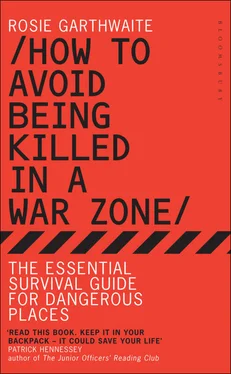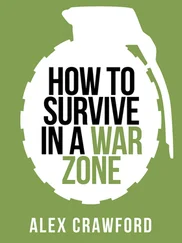Action:Treat like a normal fever (see fever) until the distinctive rash appears, then rush to hospital for treatment. If you are more than two hours from a hospital, give an antibiotic at four times the usual dose. Repeat every two hours if there is still no chance of medical attention.
Nosebleed
People always seem to think there is a secret trick to stopping a nosebleed, but there ain’t. The key is to avoid sniffing, as that will start the bleeding again. You need the blood to clot. The patient will naturally want to avoid having blood running down their throat, so lean them forward, hold the soft part of the nose and wait for the bleeding to stop. They need to continue breathing through the mouth for some time after it has stopped to avoid the urge to sniff.
Panic attack
Seeing awful or strange things for the first time, or experiencing dramatic events, can lead to symptoms that might puzzle or frighten you. I once woke up from a nightmare breathing very heavily and with my heart beating at a hundred miles an hour. I was hyperventilating (over-breathing), and passed out several times from the effects of it, but I thought I was having a heart attack. Eventually, I managed to get help and go to a hospital. There I learnt that hyperventilating can last hours, whereas a heart attack usually lasts only minutes. I also learnt that hyperventilating is just one of the symptoms of a panic attack.
First signs:Racing pulse; dizziness; sweating and cramps in the hands and feet; difficulty getting air out of the lungs (hyperventilation).
Action:Deal with the hyperventilation because relieving that will alleviate the other symptoms. Breathing in and out of a paper bag is no longer recommended as a way of calming hyperventilation. Instead, move the person to a quiet place, away from crowds, and get them to focus on their breathing, encouraging them to take slow, regular breaths. Hold them firmly, reassuring them that you are there to help.
Shock
This is not the kind of shock you might feel after experiencing a robbery or receiving bad news. That’s emotional shock, which can be cured by drinking a large mug of sugary tea. The type of shock arising from injury is a lot more serious. It means there is inadequate blood circulating and this may cause the heart, kidneys, brain or other vital organs to be deprived of oxygen. This type of shock can kill you.
Causes of shock
While there are multiple causes of shock, the most common are:
• Massive fluid loss – usually blood from internal or external bleeding, but it can also be caused by diarrhoea, vomiting, serious burns or severe constipation that leads to colon problems.
• Heart problems – these can stop the blood moving fast enough around the body to carry oxygen to your most vital organs
• Spinal cord injury
• Hypothermia – when the body’s core temperature drops below 35°C
• Low blood sugar
• Severe allergic reaction
• Drug overdose
• Major infection
First signs:Racing pulse; pale, clammy skin; sweating. As it gets worse, the pulse may fade away altogether at the wrist. The casualty will start to pant with shallow breaths. Their skin will go grey, they will feel dizzy and sick, and be screaming for water. In the final stages they will become aggressive. They will gasp and yawn for air, then fall unconscious before their heart stops.
Action:Treat the cause of the shock as best you can until the professionals arrive. You need to get as much blood as possible to the person’s heart and brain. Raise their feet or lay them on a slope with their head pointing downhill.
Poor circulation will make them cold, so keep them warm with a blanket or with your own body heat. Avoid applying anything very hot, such as a close radiator or a hot-water bottle, as it might disturb the flow of blood, which shrinks away from the heated area to try to cool the body down.
The symptoms of shock can be worsened by pain and fear, so give reassurance. Although the patient will be very thirsty, just wet their lips or give sips of water, no food. They need an empty stomach in case emergency surgery is required later.
Spinal injury
You won’t need me to tell you how dangerous it is to move someone with a spinal injury. The spine and brain are the two most fragile parts of the body, and two of the most difficult to assess in terms of injury. If there is any suspicion of a spinal injury, particularly to the neck, you must be extremely cautious (see Recovery position for a suspected spinal injuryand Pressure points to control bleeding).
Sprains
A sprain involves the tearing of muscles or ligaments around a joint, but it can feel as painful as a break and should be treated like one initially.
First signs:Swelling and bruising; pain increases when the joint is moved.
Action:Immobilize the part as early as possible (see Immobilizing fractures). Loose crêpe bandaging will work. It should not be too tight in case of further swelling.
Pack ice onto the affected area or soak in cool water as often as possible, and raise the limb to reduce swelling at night.
If your boot is already on when you sprain your ankle and you still have some walking to do, leave it there. The moment you take it off, it will swell up like a balloon, and then you are stuck carrying your boot and hopping along on one leg.
Stroke
A stroke is a collapse in part of the brain after a disruption to the blood supply. It can affect people in any number of ways, from a vague sloping of the eyes to death. As a result, strokes are notoriously difficult to recognize. Even the victim might not recognize the effects.
First signs:Facial weakness, arm weakness and speech problems. There are various tests for these:
• Face – are the features unusually uneven? Is the person able to smile? Is their mouth or eye droopy?
• Arms – can they lift both arms to the same level?
• Speech – can they speak clearly? Can they recall words easily?
Other areas may also be affected. The legs may go numb. One side of the body may appear paralysed or slumped. The vision may be affected. They may fall suddenly, or be affected by a severe sudden headache.
Action:Speed is of the essence. The earlier the patient gets medical care and rehabilitation, the better their chances of recovery. You can do very little, only support them, calm them and hold their hand while waiting for expert help. If they stop breathing, begin CPR immediately (see CPR for adults).
Sunburn (see Sunburn)
Trench foot (see Trench Foot)
Vomiting
Vomiting can be caused by any number of different problems, from food poisoning and fever to altitude and car sickness. But if it is caused by an infection, it can be passed easily from person to person if the conditions are not kept as hygienic as possible.
First signs:Gagging reflex; extra saliva in the mouth; nausea.
Action:Move the casualty away from the cause of the problem if it is physical, such as an allergy or sea sickness. Your aim is to calm them and make sure they are drinking enough fluids and salts. If the vomiting continues over a day, or is particularly severe or blood-filled, you need to get medical assistance as soon as possible.
When the casualty is well again make sure they eat only simple foods, such as pasta, bread or potatoes, for the first 24 hours.
Fortuna fortis favet (Fortune favours the brave). I never really understood this until I found myself in various dangerous situations where, invariably, the most dangerous thing was indecision. Fortuna fortis favet should not be mistaken for recklessness or aggression. Often the brave call is restraint, decisively turning back or breaking an engagement rather than pursuing it. But invariably the unlucky men who were injured in a contact, or the unfortunate teams that got stuck in difficult situations, were those who didn’t commit wholeheartedly.
Читать дальше




![Джонатан Димблби - Barbarossa - How Hitler Lost the War [calibre]](/books/385421/dzhonatan-dimblbi-barbarossa-how-hitler-lost-the-w-thumb.webp)







